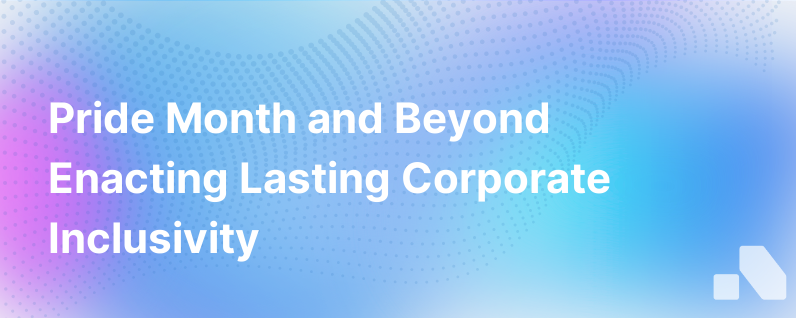Pride Month And Beyond Building Corporate Inclusivity That Lasts
Published on November 1, 2023 by David Zhang
Pride Month is traditionally celebrated annually throughout June, commemorating the Stonewall riots of 1969—an event that marked a turning point in the struggle for equal rights for the LGBTQ+ community. However, genuine inclusivity requires more than rainbow logos or a month of recognition; it necessitates ongoing commitment to cultural change, policies, and attitudes that embrace diversity year-round.
So, the important question is: How can companies move beyond token gestures to create a workplace that genuinely respects and includes all employees, including those from the LGBTQ+ community?
Creating a Foundation for Inclusion
Fostering an inclusive corporate culture starts with foundational efforts. This means integrating inclusivity into the core values of your company and ensuring that the commitment to diversity and inclusivity is clear at every level of the organization, from the C-suite to interns.
-
Culture and Core Values: The company must embody a culture that actively supports LGBTQ+ employees. This begins with crafting and enforcing core values that highlight inclusivity as a non-negotiable element of the workplace.
-
Policy and Compliance: Workplace policies should protect against discrimination based on sexual orientation, gender identity, and expression. Establish clear anti-harassment guidelines and ensure compliance with local, state, and federal laws.
-
Education and Awareness: An informed workforce is more empathetic. Provide resources and organize workshops to raise awareness about LGBTQ+ issues, terminologies, and proper allyship practices.
Ongoing Education and Celebrating Diversity
Education shouldn't be limited to new hires; it should be an ongoing process for all employees. Continuous learning opportunities foster a culture of acceptance and understanding, promoting an environment where everyone feels valued and heard.
-
Inclusive Training Programs: Conduct regular training sessions addressing unconscious bias, LGBTQ+ diversity, inclusivity, and how to prevent discrimination. Make these sessions interactive and encourage participation for greater engagement.
-
Speaker Sessions and Panels: Host talks with LGBTQ+ activists, scholars, and thought leaders to deepen understanding and hear diverse perspectives.
-
Support Groups and Alliances: Facilitate the formation of employee resource groups (ERGs) for LGBTQ+ individuals and their allies to provide a space for support and networking.
Inclusivity in Practice
Inclusive policies are only as good as their implementation. Here’s how companies can ensure that these policies are actively practiced:
-
Representation: Strive to have LGBTQ+ individuals represented at all levels, including leadership and decision-making roles. This is a crucial step in building a diverse and inclusive workplace culture.
-
Feedback Mechanisms: Establish clear channels for LGBTQ+ employees to provide feedback about inclusivity efforts and report issues. Act on this feedback to make continuous improvements.
-
Gender-Neutral Facilities: Offer gender-neutral restrooms and dress code policies to ensure that all employees feel comfortable.
-
Expansive Health Benefits: Provide health benefits that cater to the needs of LGBTQ+ employees, including comprehensive coverage for same-sex partners and transgender-inclusive healthcare options.
Leading by Example
To create a lasting culture of inclusivity, leadership must embody the values they preach. This can be achieved through various avenues:
-
Visible Support: Leaders should show their support for LGBTQ+ rights publicly, championing the cause within and outside the organization.
-
Inclusive Decision-Making: Ensure that LGBTQ+ voices are included in decision-making processes to reflect a diversity of perspectives.
After Pride Month: Sustaining Momentum
While Pride Month is a catalyst for many inclusivity initiatives, sustaining momentum throughout the year is paramount:
-
Regular Check-Ins: Have regular check-ins on inclusivity goals and the status of implementation. Don't let the conversation about LGBTQ+ inclusion be limited to Pride Month.
-
Partner with LGBTQ+ Organizations: Build year-round partnerships with organizations that support the LGBTQ+ community to stay engaged and informed.
-
Internal Reporting: Publish reports on the company’s diversity and inclusion efforts. Transparency holds the company accountable and showcases commitment.
Aligning Actions with Advocacy
Authenticity is key. Ensuring that the company's external advocacy aligns with internal practices strengthens the trust of both employees and customers:
-
Authentic Representation: Engage sincerely with the LGBTQ+ community in marketing and social media efforts. Avoid tokenism and ensure representation is accurate and respectful.
-
Supplier Diversity: Look for opportunities to do business with LGBTQ+-owned suppliers and support the broader LGBTQ+ business community.
Empowering Change Through Metrics
Lastly, what gets measured gets managed. Establishing metrics and evaluation mechanisms is key to long-term inclusivity:
-
Diversity Metrics: Keep track of diversity metrics to evaluate inclusivity efforts. Measure progress towards creating a balanced and diverse workforce.
-
Employee Surveys: Regularly survey employees on the climate of inclusivity, seeking direct input on the lived experiences of LGBTQ+ staff.
-
Retention and Advancement: Monitor retention rates and career advancement opportunities for LGBTQ+ employees to ensure fair practices.
Conclusion
Building corporate inclusivity is a continuous journey that stretches well beyond Pride Month. It requires an unwavering commitment to creating a workplace where every individual, regardless of their sexual orientation or gender identity, feels welcomed and supported. Employers that understand the value of a truly diverse workforce not only stand out as leaders in the corporate world but are paving the way for a more inclusive future in business and society at large.
Forging a genuine culture of inclusivity takes time and dedication, but the investment is worth the reward—a stronger, more versatile, and innovative company. It’s the collective responsibility of all organizational members, from CEOS to part-time employees, to foster these values and ensure everyone, including the LGBTQ+ community, can take pride in a workplace where they are respected and celebrated every day of the year.